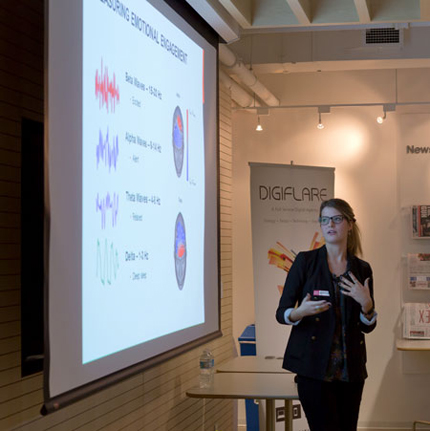“The intelligent application of technology to extend human capability and understanding is hugely exciting and an intellectual orientation open to everyone.” – Girl Geeks Toronto
In our mission to educate consumer and business audience, we provided an introduction to Neuromarketing on February 11 in Toronto. The event was hosted by Girl Geeks Toronto, a network of women (and men) who are curious about how things work, and most importantly want to implement systems and structures to work effectively. Together with Asif Khan, from the Location Based Marketing Association, Diana Lucaci and Katerina Juskey talked about how marketers are using Location Based Marketing (LBM) and how neuromarketing measures brain responses to really understand how users are truly responding to marketing messages.
Check out the full story on the Girl Geeks Toronto blog, written by Sandi Jones. Below is an excerpt.
“Diana Lucaci from True Impact brings science into the boardroom, using tools that measure brain response to show marketers how users respond to their content. She was quick to remind us that neuromarketing is not about manipulating the subject’s brain, just reading its response, and introduced us to three NM technologies:
EEG – Electroencephalography records electrical impulses produced by the brain’s activity to see whether a subject is engaged or not, or has positive or negative emotional engagement
fMRI – Functional MRI machines measure the blood-flow to areas of the brain that are responsible for decision making and gives even more insight into how the subject is reacting to content
Eye Tracking – helps correlate the emotional, attention or memory activity with the visual focus on the advertisement.
One of the big ideas behind these tools is that what people say they think and feel doesn’t always match what they really do, so focus groups and surveys can’t always give an accurate insight. Diana also pointed out that what questions we ask, how we ask them, and who else is in the room can affect subjects’ responses in traditional market research but by measuring the brain’s response neuromarketing can cut through some of that and tell us what people are really responding to. Used in conjunction with traditional research, NM can fine tune our understanding of the results.
Diana also showed us how we make decisions, with the part of our brains that handles emotions causing us to respond – mentally and even physically – before we even begin to think about a decision, and urged us to keep that in mind when we’re making decisions. Even when we don’t think we’re being affected, we are, and the fMRI can measure that.

One of Diana’s intriguing use cases involved three stop-smoking ads being shown to a focus group, which chose ad “B” as the most effective, while fMRI scans showed people really preferred ad “C” and in the real world, ad “C” drove 3 times as many calls as the others. Ads “A” and “B” were both based on rational arguments against smoking, the reasons we all want to believe we make decisions, while ad “C” tugged the heartstrings, addressing how hard it is to quit and how smoking affects our families. The fMRI was able to show that despite what the focus group respondents told marketers (and themselves!) the emotional appeal is the one that really worked.

While the fMRI gives the deepest insights, EEG is a very effective tool because it provides immediate readings and it’s more portable and easy to use. Katerina told us about EEG’s and how they can show negative and positive responses and whether the subject is really engaged or tuned out. They also showed us a great example of how eye tracking can help us improve campaigns. Eye tracking on an ad showed most time spent looking at the headline, a little at the model, and almost none at the product. By changing the ad so that the model was looking at the bottle, viewers’ behaviour was changed and they spent more time looking at the product. Eye tracking identified what was happening, cueing marketers to make changes, and then measured the result to show that the change worked.
Diana acknowledged that neuromarketing is quite new, but she likened selling it to selling some of the earliest websites. Many of us can remember when businesses were skeptical about whether a website would really drive business, but now there’s no question about it. Similarly, Diana expects neuromarketing to become more mainstream as marketers gain more experience using it.”